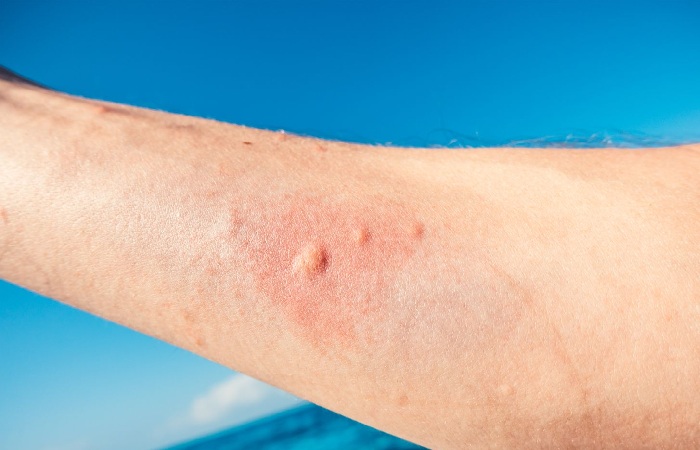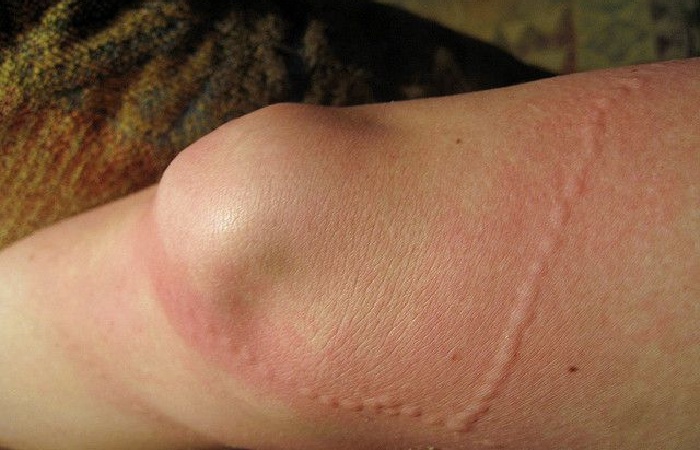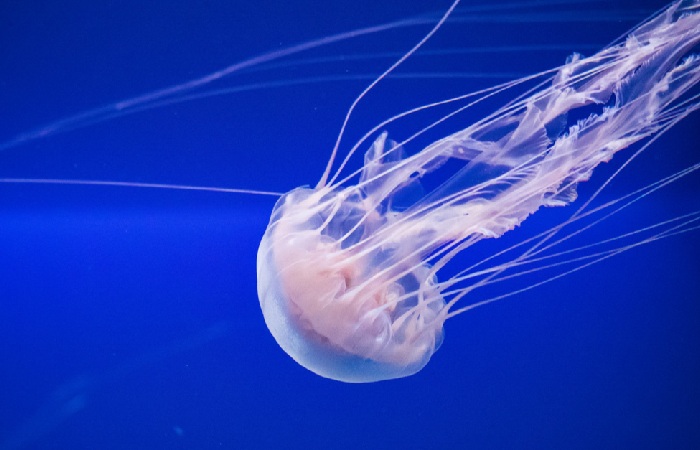Table of Contents
Introduction
Jellyfish are invertebrate animals that, with their sting, can end up making a happy day at the beach nasty. They float in the seawater and have no interest in attacking us. Still. The mere touch. Especially with their tentacles, activate their stinging cells in the form of microscopic stingers through which they release their poison.
Dependent on the kind of jellyfish in question. It can have mild or severe significance, but, in any case, it is always good to know what to do to relieve a jellyfish sting. Their presence on the beaches, sometimes in large numbers mainly due to climate change and the increase in sea temperature. Can become a real problem, and there is no lack of measures that try to prevent their massive arrival on the coasts.
Symptoms of a Jellyfish Sting

Usually, a jellyfish sting is felt almost immediately as an intense and sudden stinging pain, as if you had burn. But, of course, the consequences depend on different factors. For example. The portion of the body where you have stung. With the chest and back being the most sensitive areas In addition to the face; time of exposure to the jellyfish’s venom (a light touch is not the same as the animal catching you completely by coiling its tentacles around an arm or a leg without letting go) and. Lastly. The extension or size of the sting are the main factors that determine whether the symptoms are more or less severe.
In addition, it must remember that there are more or less dangerous jellyfish. Although the symptoms may vary depending on the type of jellyfish in question, the most common include:
Itching and intense burning in the affected area (one of the usual symptoms of any sting).
Inflammation and localized pain, especially in the case of a sting from the so-called ‘agua mala’ jellyfish, which is significant, and also from the particularly dangerous Portuguese skull.
Red or purple marks allow you to perfectly identify where the jellyfish’s spear has come into contact with the skin.
Headache and General Condition.
Muscle cramps, vomiting, breathing difficulties (only in the most severe cases of bites of the most dangerous and poisonous species).
What to do to Relieve a Jellyfish Sting?

If. While in the water. Or once drying yourself on the sand, you notice that you have stung by a jellyfish, keep calm because, in most cases, the intense itching and pain will subside little by little. First,
However, we recommend you follow these Tips in Case of a Jellyfish Sting:
Of course, if we are talking about severe reactions, go to receive medical attention immediately.
To find the relief you need and disease the effects, the first thing to do when a jellyfish hurt you is clean the wound. But never use fresh water because it aggravates the symptoms. Upon contact with fresh water, the remains of poisonous cells that may have remained attache to the skin can cause the jellyfish sting to reactivate. Releasing more poison and increasing the unbearable burning sensation you feel. So instead. You must wash the affected area with some saline physiological serum or even directly with seawater, constantly pouring it without rubbing or scrubbing (no matter how itchy).
Removing any small remains of an attached tentacle is essential, but never do it directly with your fingers if not using tweezers or resistant gloves.
One treatment for a jellyfish sting is to apply ice. Especially if there is inflammation, to relieve the jellyfish sting, but remember never to put it directly on the wound. Instead. Wrap it in a cloth that you will have to put in a plastic bag so that, when it melts. The freshwater does not come into contact with the skin.
To relieve the pain, you can take an analgesic and remember that many popular remedies, such as applying urine or throwing sand on the reddened area, are completely inadvisable. Although you can use ammonia for insect stings, jellyfish stings are not recommend, as they could also worsen the situation. The only item you can do is put on a little vinegar, which does work when it comes to stopping the action of the poison.
How to Avoid a Jellyfish Sting?

It is not easy to avoid a jellyfish sting because these animals float in the sea. Letting themselves be carried away by the current, and, being almost transparent, they are not easy to see in time. Even so, there are some preventive measures that it is worth remembering:
Please find out about the conditions of the beach where you are and pay attention to the information offered by the warning flags and the lifeguards who ensure the safety of bathers. That red flag indicates that bathing is prohibited may be due to the excessive presence of jellyfish.
Put on sunscreen. Not only because it is essential to sunbathe without damaging your skin but also because a waterproof cream will give you minimal protection against accidental brushing with a jellyfish.
If you see one in the water. Walk or swim slowly away. Without disturbing the water too much, since, with the movement of the waves that you form swimming at full speed in its presence, they could bring them even closer to you. If you see not one but several, don’t think about it. Get out of the water.
Conclusion
It is significant to remember that you should not touch a jellyfish even if it is in the sand and appears dead and harmless. It may not be. And when you feel it (or step on it while walking along the shore), it will sting you as if it were in the water. In this sense, be careful with the little ones. Whose curiosity can lead them to touch a jellyfish, already in the sand, which still has more poison than it seemed.
Also Read: What are Intestinal Bacteria, and why are they Significant?
Related posts
Featured Posts
Best Gynecologist in Kolkata
What do you mean by a Gynecologist? The studies and treatments of the medical conditions and diseases of women are…
Face Swimsuit – A Breakdown of Swimsuit Styles
Introduction Face Swimsuit – Make your very own face swimsuit in two fabrics and eight sizes. Face-on swimsuit print is…


